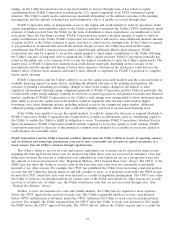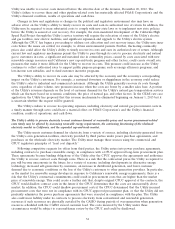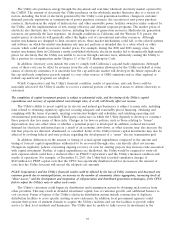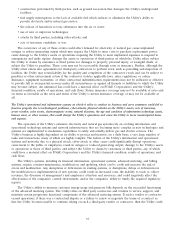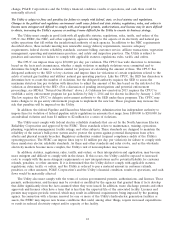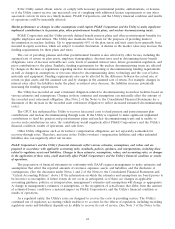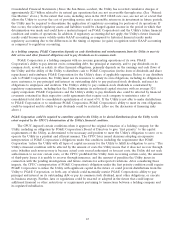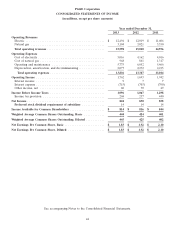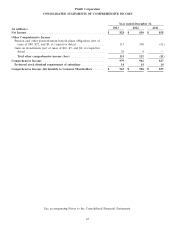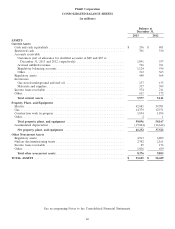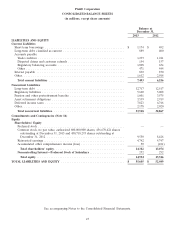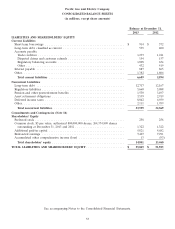PG&E 2013 Annual Report Download - page 49
Download and view the complete annual report
Please find page 49 of the 2013 PG&E annual report below. You can navigate through the pages in the report by either clicking on the pages listed below, or by using the keyword search tool below to find specific information within the annual report.Consolidated Financial Statements.) Since the San Bruno accident, the Utility has recorded cumulative charges of
approximately $2.5 billion related to its natural gas operations that are not recoverable through rates. (See ‘‘Natural
Gas Matters’’ above.) To the extent that rates, including rates in the 2015 GT&S rate case, are not set at a level that
allows the Utility to recover the cost of providing service and a reasonable return on its investment in future periods,
the Utility may be required to discontinue the application of regulatory accounting for portions of its operations. If
that occurs, the related regulatory assets and liabilities would be charged against income in the period in which that
determination was made and could have a material impact on PG&E Corporation’s and the Utility’s future financial
condition and results of operations. In addition, if regulatory accounting did not apply, the Utility’s future financial
results could become more volatile under GAAP accounting as compared to historical financial results under
regulatory accounting due to the differences in the timing of expense (or gain) recognition under GAAP accounting
as compared to regulatory accounting.
As a holding company, PG&E Corporation depends on cash distributions and reimbursements from the Utility to meet its
debt service and other financial obligations and to pay dividends on its common stock.
PG&E Corporation is a holding company with no revenue generating operations of its own. PG&E
Corporation’s ability to pay interest on its outstanding debt, the principal at maturity, and to pay dividends on its
common stock, as well as satisfy its other financial obligations, primarily depends on the earnings and cash flows of
the Utility and the ability of the Utility to distribute cash to PG&E Corporation (in the form of dividends and share
repurchases) and reimburse PG&E Corporation for the Utility’s share of applicable expenses. Before it can distribute
cash to PG&E Corporation, the Utility must use its resources to satisfy its own obligations, including its obligation to
serve customers, to pay principal and interest on outstanding debt, to pay preferred stock dividends, and meet its
obligations to employees and creditors. The Utility’s ability to pay common stock dividends is constrained by
regulatory requirements, including that the Utility maintain its authorized capital structure with an average 52%
equity component. PG&E Corporation’s and the Utility’s ability to pay dividends also could be affected by financial
covenants contained in their respective credit agreements that require each company to maintain a ratio of
consolidated total debt to consolidated capitalization of at most 65%. If the Utility is not able to make distributions
to PG&E Corporation or to reimburse PG&E Corporation, PG&E Corporation’s ability to meet its own obligations
could be impaired and its ability to pay dividends could be restricted. (Also see the discussion of financing risks
above.)
PG&E Corporation could be required to contribute capital to the Utility or be denied distributions from the Utility to the
extent required by the CPUC’s determination of the Utility’s financial condition.
The CPUC imposed certain conditions when it approved the original formation of a holding company for the
Utility, including an obligation by PG&E Corporation’s Board of Directors to give ‘‘first priority’’ to the capital
requirements of the Utility, as determined to be necessary and prudent to meet the Utility’s obligation to serve or to
operate the Utility in a prudent and efficient manner. The CPUC later issued decisions adopting an expansive
interpretation of PG&E Corporation’s obligations under this condition, including the requirement that PG&E
Corporation ‘‘infuse the Utility with all types of capital necessary for the Utility to fulfill its obligation to serve.’’ The
Utility’s financial condition will be affected by the amount of costs the Utility incurs that it does not recover through
rates (whether such non-recovery is because actual costs exceed authorized or forecast costs, the Utility did not seek
authorization to recover certain costs, or the CPUC prohibited the Utility from recovering certain costs), the amount
of third-party losses it is unable to recover through insurance, and the amount of penalties the Utility incurs in
connection with the pending investigations and future citations for self-reported violations. After considering these
impacts, the CPUC’s interpretation of PG&E Corporation’s obligation under the first priority condition could require
PG&E Corporation to infuse the Utility with significant capital in the future or could prevent distributions from the
Utility to PG&E Corporation, or both, any of which could materially restrict PG&E Corporation’s ability to pay
principal and interest on its outstanding debt or pay its common stock dividend, meet other obligations, or execute
its business strategy. Further, laws or regulations could be enacted or adopted in the future that could impose
additional financial or other restrictions or requirements pertaining to transactions between a holding company and
its regulated subsidiaries.
43


